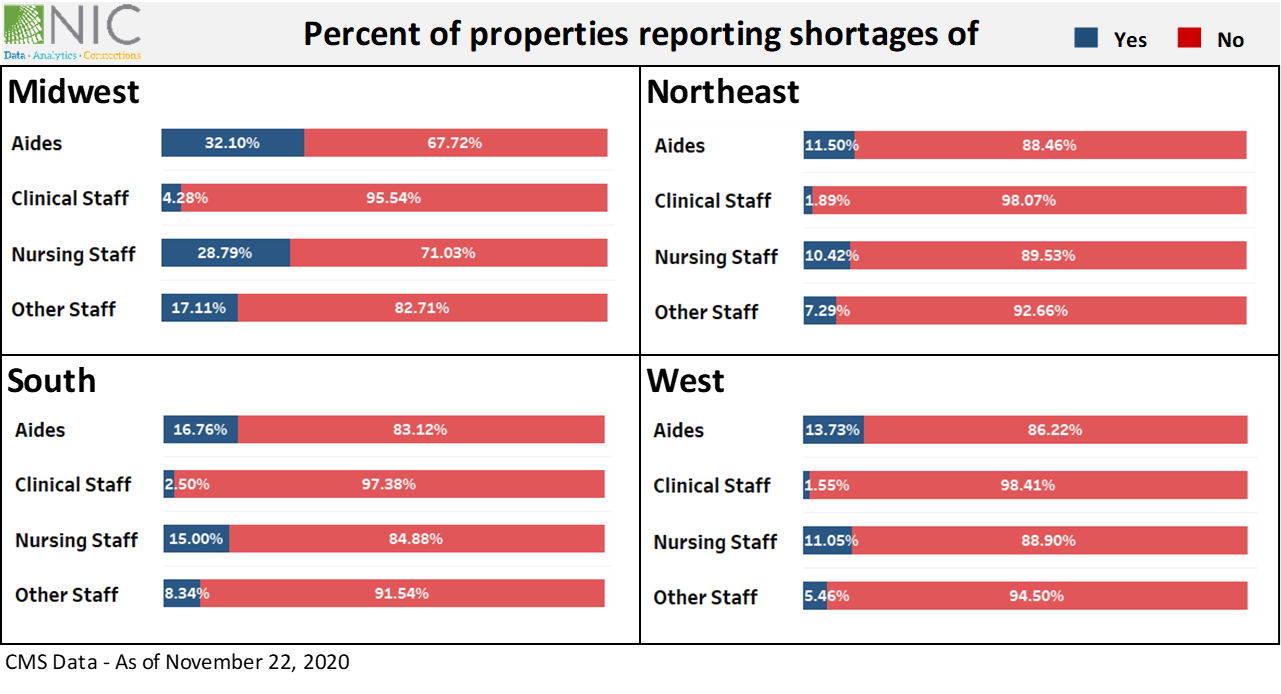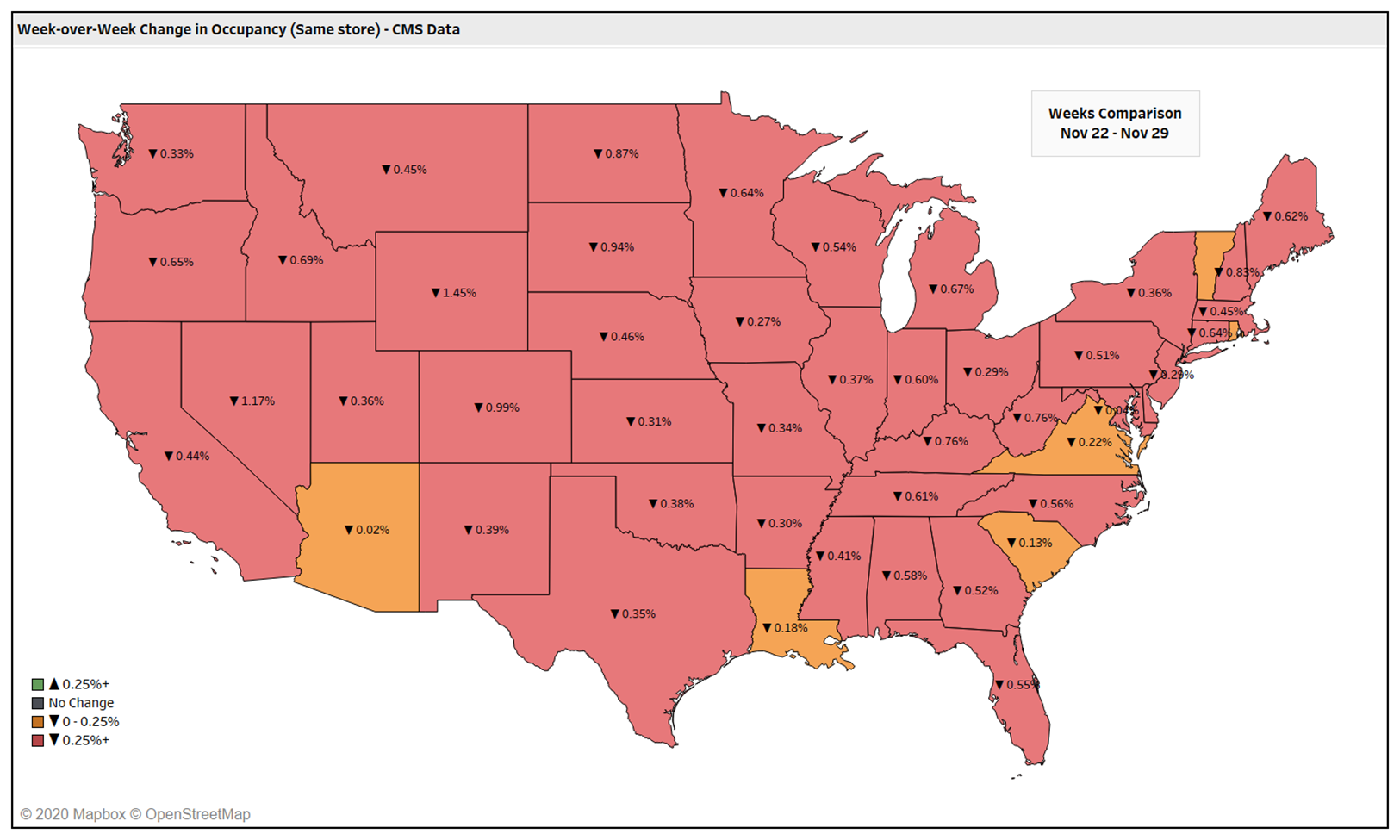Staffing shortages continue to be a serious concern and a contributing factor driving the high number of cases and fatalities across the four regions.
The Centers for Medicare & Medicaid Services (CMS) provides up-to-date information on the incidence of COVID-19 cases among nursing facilities as well as fatality statistics associated with COVID-19. The NIC Skilled Nursing COVID-19 Tracker (Tracker) was recently updated to include fatality counts. This is the fourth sorting metric available in the Tracker. The other sorting options include same-store occupancy (CMS data), new COVID-19 confirmed cases as a share of residents, and new COVID-19 confirmed cases per same store facilities.
Data for November 29 showed that Midwest properties continued to report high numbers of new COVID cases: 6,574 among staff/personnel and 6,663 new residents’ cases within 4,104 facilities. This accounted for over 40% of overall new cases and was equivalent to 2.65% rate of newly confirmed cases among residents. This was the highest rate recorded across all four U.S. regions since CMS began reporting nursing homes COVID-19 data in late May. The South reported the second highest rate at 1.53%, followed by the Northeast (1.22%), and West (1.01%).
 *Exhibit 1 – Source: NIC Skilled Nursing COVID-19 Tracker
*Exhibit 1 – Source: NIC Skilled Nursing COVID-19 Tracker
Exhibit 1 shows that the share of properties reporting new confirmed cases on a weekly basis has increased dramatically in the Midwest from 9.4% on May 31 to 32.2% on November 29. The South and West regions experienced an increase of 11.2 percentage points to 22.3% and 4.5 percentage points to 14.1%, respectively. The Northeast rate saw a slight uptick from its highest peak of 25.2% recorded in late May to 26.1%.
Although the number of new COVID-19 confirmed cases has reached new records since the pandemic began, the number of fatalities in the Northeast and West regions remains below the high points seen earlier in the pandemic. The West reported the lowest rate of fatalities as a share of residents at 0.14%, followed by the Northeast (0.17%), down from 0.46% on May 31. However, the Tracker shows that COVID-19 fatalities reached unprecedented levels in the Midwest as new cases rose to the highest levels since the month of October. There, new fatalities among residents reached 0.49% on November 29, double the rate recorded on May 31 (0.24%).

*Exhibit 2 – Source: NIC Skilled Nursing COVID-19 Tracker
CMS data depicted in Exhibit 3 show that properties in the Midwest also experienced high shortages of aides, clinical staff, nursing staff and other staff in general. About one-third (32.1%) of properties reported shortages of aides and nearly 29% were critically short on nursing staff for the week ending November 22. Notably, shortages of aides and staff in the Northeast were relatively few. This suggests that staffing shortages continue to be a serious concern and a contributing factor driving the high number of cases and fatalities across the U.S. four regions, particularly, in the Midwest and South.

*Exhibit 3 – Source: NIC Skilled Nursing COVID-19 Supplemental Data
In terms of CMS-reported occupancy rates, the Midwest had the lowest rate of 67.5% on November 29. The South’s occupancy rate fell to 68.1%, down 3.7 percentage points from May 31 levels.
Skilled nursing properties in the Northeast maintained their weekly occupancy levels above 73% over the past six months and rank highest among the four regions. In fact, occupancy increased by 0.3 percentage points on November 29 from May 31 levels. The West reported the second highest rate of 71.4%.
For the first time since the pandemic began, all U.S. states showed a decrease in occupancy on a week-over-week basis between November 22 and November 29.

*Exhibit 4 – Source: NIC Skilled Nursing COVID-19 Tracker
The FDA approved Pfizer’s COVID-19 vaccine for distribution on December 11 and is moving to authorize the vaccine made by Moderna. Health care workers and nursing home residents are a top priority for COVID-19 vaccines. While this is promising, it remains ever important to stay vigilant for the next few months until a vaccine is widely distributed.
To gain in-depth insights and track the week-over-week change rate for new resident cases of COVID-19 within skilled nursing properties at the state and county levels, visit NIC’s Skilled Nursing COVID-19 Tracker. Access to the Skilled Nursing COVID-19 Tracker as well as a rich trove of analysis and insights can also be found on the NIC COVID-19 Resource Center.